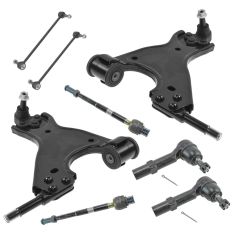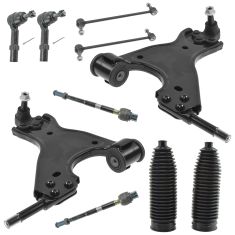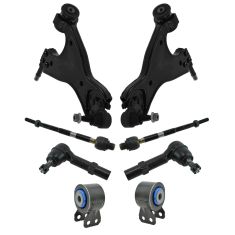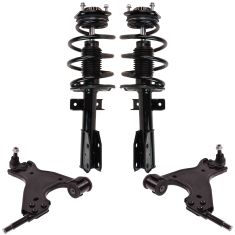1ASFK03511-Chevrolet GMC Buick Saturn Front Lower 4 Piece Control Arm with Ball Joint Set TRQ PSA62531
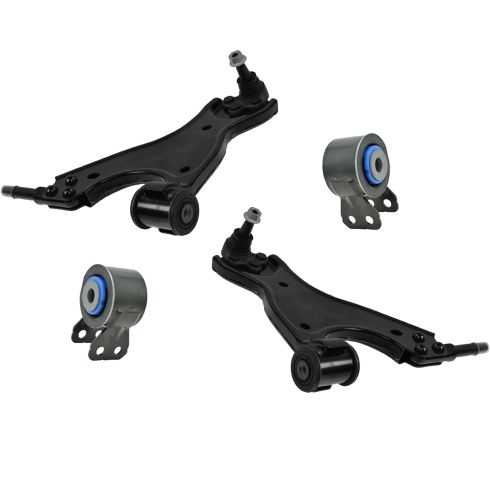
Replaces
2008 Buick Enclave Front Lower 4 Piece Control Arm with Ball Joint Set TRQ PSA62531

Product Reviews
Loading reviews
4.71/ 5.0
31
31 reviews
Control arms good, bushings are weak causing rough ride
July 23, 2018
Control arms were easy to install the videos helped a lot. My only issue was the bushings. They had a lot of play and made my car ride rough. I changed those out with Moog from a local parts store and fixed the problem. The control seem to be holding up so far though.
Perfect
October 21, 2018
I ordered parts from 1aauto and the parts were the right parts the first time, shipping was speedy and parts are working great.
Loyal Customer for Life!!!
July 19, 2019
Great Parts, Amazing Prices. A1 Auto Loyal Customer for Life!
Perfect Fit and fast free shipping
September 17, 2019
This was an exact fit and i received before the date it qas scheduled to arrive.
Great part for a good price
October 2, 2019
Great parts and a good price and the how to videos make it possible for just about anyone to service their vehicle. I would recommend these parts
Installation Video Problems
October 4, 2019
I have purchased many parts from these guys and have been very happy with the quality of the parts you get for the price. That means a lot to a do-it-yourselfer and I also really appreciate the installation videos that they provide for the parts you buy. With these control arms/ball joints though, the installation video didn't outline the correct procedure when it came to tightening down the nut on the ball joint. To make a long story short the video shows the mechanic tightening down the nut very simply by using a wrench with a cheater. Easy enough until I got to that step and found that the ball joint shaft rotates freely when trying to tighten the nut the provided. To hold the shaft in place while tightening the nut they cut an opening for an allen wrench to be inserted while you tighten the nut. The problem is that an allen wrench doesn't fit between the ball joint shaft and the cv axle. There is no space to use one of those multi angle allen wrenches with the special head either b
Perfect fit!
February 15, 2020
Excellent product! ?? Fast delivery!
Great parts
March 22, 2020
Perfect fit. Quality parts. The video was a great help.
Great Parts, Perfect Fit
August 6, 2020
Ive used 1A Auto several times, for my wifes and sons cars. Purchased these lower control arms and bushings for our Traverse. The video made install very easy, parts fit perfectly. Prices also very reasonable. 1A Auto will continue to be my Go-To parts guys.
Traverse lower control arms
August 18, 2020
Bought these lower control arms and bushings for 2012 Traverse. Great quality parts that are priced right! As always, the video makes it very easy to install. Now front end is nice and tight again.
1a parts
October 11, 2020
The parts were easy to install and have been working great!
Satisfied customer
August 10, 2021
Delivered on time and packaging was great. No complaints here. Would def order from 1-A auto. Weve always been very satisfied with their service and products.
Control Arms
August 30, 2021
As advertised. Name Brand repair shop wanted lots of money to just replace the Bushings.....this kit gives it to you all for a fraction of the price for a DIY Guy
October 30, 2021
Worked great
December 20, 2021
Fit perfectly !
Works as expected
January 26, 2022
Fit as expects on our 2010 GMC Acadia
March 15, 2022
Very good part and a lot less money.
Will order from 1A Auto again
April 4, 2022
Fast delivery, parts were solid and installation was quick.
Buy if on a budget
June 10, 2022
Thought the price was good but after getting everything in place and tightened up the nut that goes on the ball joint stud only goes about 1/4 way on then gets stuck and cant tighten all the way starter by hand and can only use a box end wrench as your limited to space, highly disappointed on this purchase
July 20, 2022
Exactly what I need
I only order from you guys because I like the way you do business
July 25, 2022
Good quality products thank you
Good parts,good price,good shipping
October 17, 2022
Parts fit and looked ( except without all the slop from miles of use)just like the factory ones I took off! Happy so far. Only have about 200 miles of use on them.
March 4, 2023
Bushings and control arm kit were exact match for my Buick and installed very easily, thanks to videos from 1A Auto!
Exact what I needed
May 6, 2023
Easy to install
Good parts
May 31, 2023
Parts worked fine.
[{"url": "https://wac.edgecastcdn.net/001A39/prod/media/pNISJll75W64CYGsite/729cce487bb8c7e62c0d54d5dd16ca68_1691476232180_0.jpeg", "caption": ""}, {"url": "https://wac.edgecastcdn.net/001A39/prod/media/pNISJll75W64CYGsite/e42939e866a07bf647ca0fd31321554e_1691476232180_1.jpeg", "caption": ""}]
August 8, 2023
Easy af to install perfect kit to help inner tire wear ball joints goin bad they also help with all the other suspension parts to make ride handle better in corners and bumps smooth ride
Fantastic price, even better quality
December 1, 2023
parts went on flawlessly and are doing excellent, highly recommend.
December 7, 2023
Real easy to install fit was perfect
Review of items
March 26, 2024
It looked just like the picture above the parts was nice and super clean and I love my parts make my ride my smoother and thanks to A1 Auto for great customer support and fast delivery
Highly recommend
May 12, 2024
Great. Easy to install work well. Shipped fast
Very happy ??
September 10, 2024
Everything fit perfectly as always!!!
Thank you 1A (Auto)
Customer Q&A
are these control arms are for driver and passanger?
July 18, 2023
10
Yes, this is a pair of control arms that includes the driver and passenger sides.
July 19, 2023
Meghan R
10
There for both sides
August 15, 2023
Michael R
Buick is a registered trademark of General Motors Company. 1A Auto is not affiliated with or sponsored by Buick or General Motors Company.
See all trademarks.









